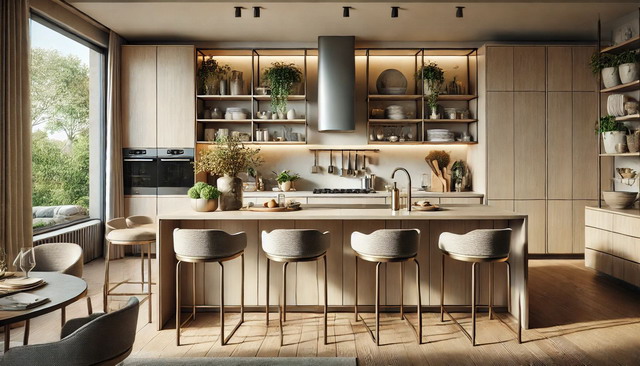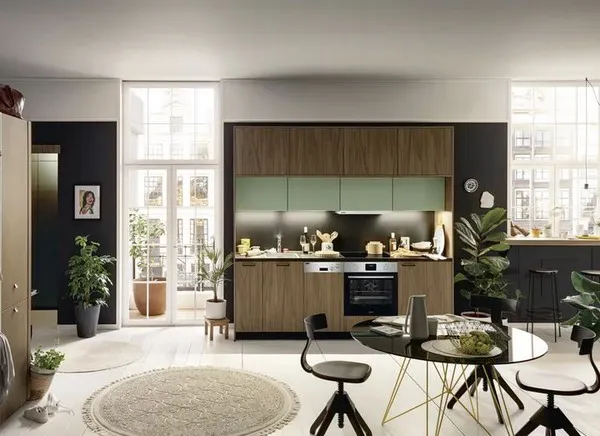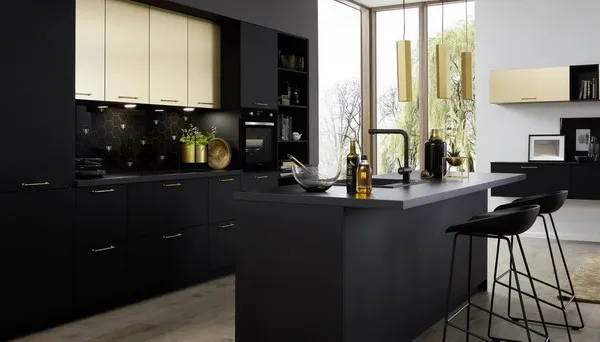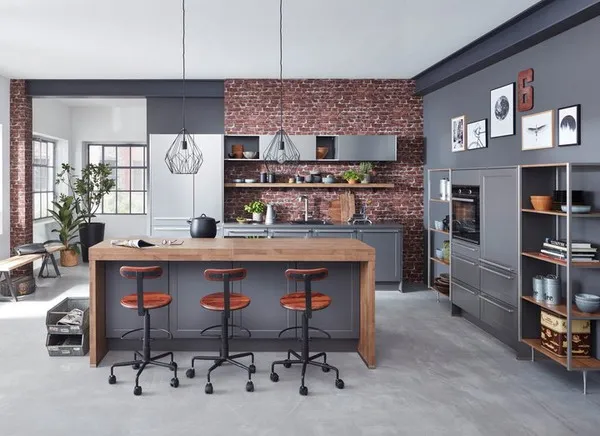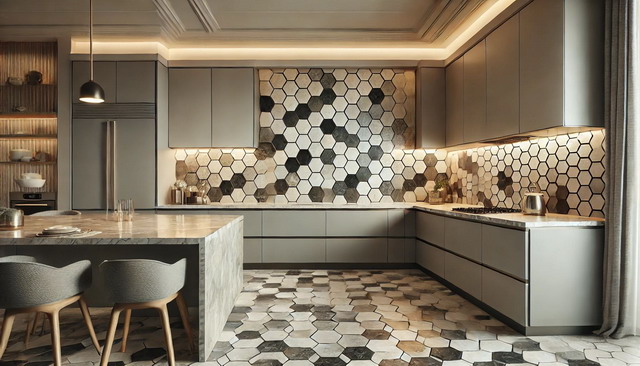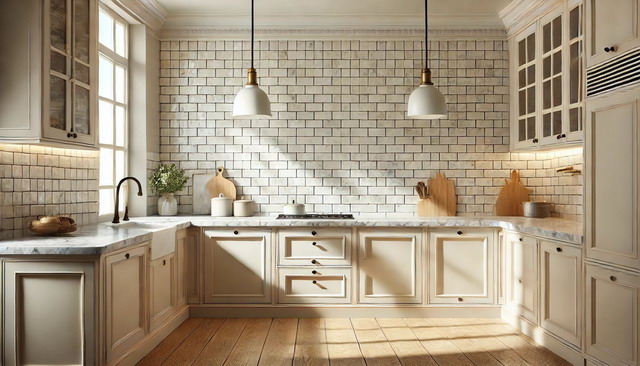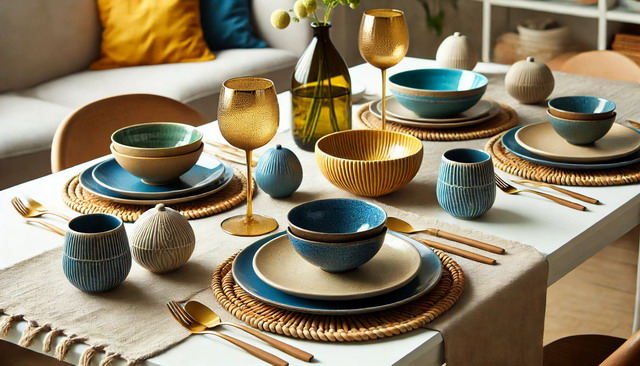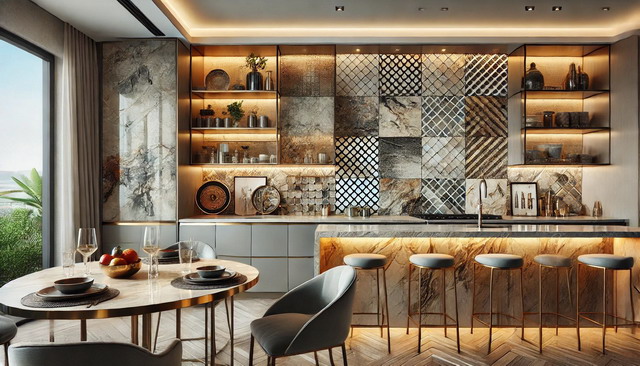Kitchen Furniture Trends 2025: Transform Your Space with the Latest Designs
Last Updated on August 30, 2024 by Mutiara
The kitchen is more than just a place to prepare meals—it’s the heart of the home, where style meets functionality and memories are made. As we approach 2025, the world of kitchen furniture is undergoing a significant transformation. Driven by evolving lifestyles, technological advancements, and a growing emphasis on sustainability, the kitchen of the future is set to be smarter, more eco-friendly, and increasingly personalized. This blog post explores the trends that are defining kitchen furniture in 2025, starting with the journey that has brought us here and the rise of sustainable materials as a cornerstone of modern design.
The Journey to 2025: How Kitchen Furniture Has Evolved
The evolution of kitchen furniture has mirrored broader changes in society, from shifts in design aesthetics to new ways of living. In the past, kitchens were primarily functional spaces, often hidden away from the rest of the house. The emphasis was on durability and efficiency, with little thought given to design or aesthetics. However, as open-plan living became more popular in the late 20th and early 21st centuries, the kitchen began to take on a new role as the social hub of the home. This shift brought with it a demand for furniture that was not only practical but also stylish and integrated with the rest of the home’s design.
By the mid-2010s, minimalism had become a dominant trend in kitchen design. Clean lines, simple forms, and neutral color palettes were all the rage, reflecting a desire for spaces that were uncluttered and serene. At the same time, there was a growing awareness of the environmental impact of consumer choices. This led to an increased demand for sustainable materials and practices, both in the construction of kitchen furniture and in the kitchen as a whole.
As we move towards 2025, these trends have continued to evolve. Minimalism has matured, giving way to a more nuanced approach that balances simplicity with warmth and personality. Sustainability has moved from being a niche concern to a central tenet of modern kitchen design, influencing everything from the materials used in furniture to the way kitchens are designed and built.
Sustainable and Eco-Friendly Materials: The Foundation of 2025 Kitchen Design
In 2025, sustainability is not just a buzzword—it’s a necessity. As concerns about climate change and environmental degradation grow, consumers are increasingly seeking out products that have a minimal impact on the planet. This shift is particularly evident in kitchen furniture, where the use of sustainable and eco-friendly materials has become a defining trend.
The Rise of Recycled and Reclaimed Materials
One of the most significant trends in kitchen furniture for 2025 is the use of recycled and reclaimed materials. Manufacturers are increasingly turning to materials like reclaimed wood, recycled metal, and repurposed plastics to create furniture that is both beautiful and environmentally friendly. These materials not only reduce the demand for new resources but also bring a unique, characterful aesthetic to kitchen spaces.
Reclaimed wood, for example, is a popular choice for kitchen cabinetry and countertops. Each piece of wood tells a story, with its own history, knots, grain patterns, and color variations. This not only adds warmth and texture to the kitchen but also aligns with the growing trend toward authenticity and individuality in home design. Similarly, recycled metals like aluminum and steel are making their way into kitchen furniture, offering a sleek, modern look that is both durable and sustainable.
Repurposed plastics are also becoming more common in kitchen design. These materials are often used in innovative ways, such as in the creation of countertops, backsplashes, and even furniture. By giving new life to materials that would otherwise end up in landfills, these products help reduce waste and promote a more circular economy.
Bamboo and Cork: Renewable Resources in Kitchen Design
In addition to recycled materials, renewable resources like bamboo and cork are gaining popularity in kitchen furniture design. Bamboo, known for its rapid growth and strength, is being used in everything from cabinetry to flooring. Its natural color and grain pattern add a touch of warmth and elegance to any kitchen, while its sustainability credentials make it an appealing choice for eco-conscious consumers.
Cork, another renewable resource, is also making waves in kitchen design. Known for its durability and resilience, cork is being used in a variety of applications, from flooring to wall coverings and even furniture. Its natural insulating properties make it an excellent choice for flooring, while its soft texture and warm color add a sense of comfort and coziness to the kitchen. Cork is also highly renewable, with the cork oak tree able to regenerate its bark every few years, making it a sustainable choice for environmentally conscious consumers.
The Impact of Sustainability on Design
The emphasis on sustainability is not just changing the materials used in kitchen furniture—it’s also influencing the way kitchens are designed. In 2025, there is a growing trend toward designing kitchens that are more durable, with furniture and fixtures that are built to last. This shift is partly a response to the environmental impact of disposable culture, but it’s also driven by a desire for quality and craftsmanship in the home.
As a result, we’re seeing a return to traditional joinery techniques and a focus on creating furniture that is timeless, rather than trendy. This approach not only reduces waste but also ensures that kitchens are designed to stand the test of time, both in terms of style and functionality.
Moreover, sustainability is encouraging more thoughtful consumption. Consumers are increasingly opting for fewer, better-quality pieces that are designed to last, rather than filling their kitchens with cheap, mass-produced furniture. This trend is leading to a renaissance in craftsmanship, with more people seeking out artisanal products that are made with care and attention to detail.
Smart Kitchen Furniture: The Integration of Technology in 2025
As we step further into 2025, technology is becoming an integral part of kitchen furniture, transforming the way we interact with our cooking spaces. The kitchen is no longer just a room for preparing meals; it’s evolving into a hub of innovation where smart technology enhances convenience, efficiency, and even safety. From intelligent storage solutions to connected appliances, the integration of smart features into kitchen furniture is revolutionizing home design.
The Rise of Smart Kitchen Furniture
The concept of a “smart kitchen” has been gaining traction for several years, but 2025 marks a significant leap forward in the sophistication and ubiquity of smart kitchen furniture. This trend is driven by the rapid advancement of the Internet of Things (IoT), which allows everyday objects to connect to the internet and communicate with each other.
In 2025, smart kitchen furniture is designed to simplify tasks, save time, and reduce energy consumption. For example, smart countertops can double as induction cooktops, allowing you to cook directly on the surface while also serving as a workspace. These countertops are equipped with touch controls and temperature sensors, ensuring precise cooking while maintaining a sleek, minimalist appearance.
Another example is smart cabinetry, which includes features like motorized drawers that open and close with a touch, integrated lighting that adjusts based on the time of day, and sensors that monitor the contents of your pantry. These cabinets can even send alerts to your smartphone when you’re running low on certain ingredients, helping you stay organized and reduce food waste.
Connected Appliances and Furniture Integration
One of the most exciting aspects of smart kitchen furniture in 2025 is the seamless integration of connected appliances. Refrigerators, ovens, dishwashers, and even smaller gadgets like coffee makers are now designed to work in harmony with your kitchen furniture, creating a cohesive and highly functional space.
For instance, smart refrigerators are equipped with internal cameras that allow you to check the contents from your smartphone, even when you’re at the grocery store. These refrigerators can also suggest recipes based on the ingredients you have on hand, helping you plan meals more efficiently. Similarly, smart ovens are now capable of adjusting cooking times and temperatures automatically based on the recipe you’re following, ensuring perfect results every time.
In addition to appliances, smart kitchen furniture also integrates with voice-activated assistants like Amazon Alexa or Google Assistant. This allows you to control various aspects of your kitchen with simple voice commands, from adjusting the lighting and setting timers to preheating the oven and ordering groceries online. The result is a kitchen that not only looks modern but also functions as a high-tech command center for your home.
Minimalist and Functional Design: The Beauty of Simplicity
While technology is playing a significant role in the kitchens of 2025, there’s also a strong trend towards minimalist and functional design. This approach focuses on creating spaces that are both aesthetically pleasing and highly practical, with an emphasis on clean lines, uncluttered surfaces, and efficient use of space.
The Essence of Minimalist Design
Minimalism has been a popular design philosophy for many years, but in 2025, it has evolved to become more than just a trend—it’s a way of life. The minimalist kitchen is designed to be serene, with a focus on simplicity and functionality. This means getting rid of unnecessary clutter, choosing high-quality materials, and incorporating design elements that serve multiple purposes.
In terms of furniture, this translates to sleek cabinetry with hidden handles, integrated appliances that blend seamlessly into the overall design, and open shelving that provides both storage and display space. The color palette in a minimalist kitchen is typically neutral, with shades of white, gray, and black dominating. However, natural materials like wood and stone are often used to add warmth and texture, preventing the space from feeling too sterile.
Functionality at the Forefront
In 2025, the focus on functionality in kitchen design is stronger than ever. Homeowners are looking for furniture that not only looks good but also enhances the efficiency of their kitchen. This has led to the popularity of modular and multi-functional furniture, which can be adapted to suit different needs and spaces.
For example, kitchen islands are now being designed with built-in storage, seating, and even cooking facilities, making them the ultimate multi-functional piece. Similarly, pull-out pantry systems and corner cabinets with rotating shelves maximize storage space while keeping everything easily accessible. The goal is to create a kitchen that is not only beautiful but also works hard for its owners.
Customization and Personalization: Making the Kitchen Your Own
As kitchens become more integrated with technology and minimalist design principles, there’s also a growing desire for customization and personalization. In 2025, homeowners want their kitchens to reflect their personal tastes and lifestyle, leading to a trend towards bespoke furniture and tailored design solutions.
The Appeal of Custom Kitchen Furniture
Custom kitchen furniture is all about creating a space that is uniquely yours. Whether it’s a one-of-a-kind kitchen island, custom cabinetry, or personalized finishes, homeowners are increasingly seeking out furniture that is made to their exact specifications. This trend is driven by the desire for individuality in a world where mass-produced goods are the norm.
Custom furniture allows you to choose every detail, from the materials and finishes to the size and layout. This means you can create a kitchen that perfectly suits your cooking habits, storage needs, and aesthetic preferences. For example, if you love to bake, you might opt for a kitchen island with a built-in marble pastry slab, or if you entertain frequently, you could choose a dining table that expands to accommodate extra guests.
Personalization Through Technology
Technology is also playing a role in the personalization of kitchen furniture in 2025. With advancements in 3D printing and computer-aided design (CAD), it’s easier than ever to create bespoke furniture that fits your exact needs. You can work with designers to create custom pieces that are tailored to your space, whether it’s a uniquely shaped countertop or a custom storage solution.
Moreover, smart technology allows for even greater personalization. For instance, smart lighting systems can be programmed to adjust to your preferred brightness and color temperature, creating the perfect ambiance for cooking, dining, or entertaining. Similarly, smart appliances can be customized to suit your cooking preferences, from the way your coffee is brewed in the morning to the temperature at which your oven preheats.
Vintage and Retro Influences: A Nod to the Past in Modern Kitchens
As we move through 2025, there’s a growing appreciation for the styles of the past, with vintage and retro influences making a significant comeback in kitchen design. This trend reflects a desire for nostalgia and comfort, combining the best of yesteryear’s aesthetics with today’s functionality. The kitchens of 2025 are seeing a delightful blend of old and new, where timeless designs meet modern conveniences.
The Return of Vintage and Retro Styles
Vintage and retro styles are resonating with homeowners who seek to create warm, inviting spaces that evoke a sense of nostalgia. The charm of mid-century modern design, with its clean lines and organic forms, is particularly popular, bringing a touch of the 1950s and 60s into the contemporary kitchen.
In 2025, we’re seeing a resurgence of vintage-inspired appliances that blend seamlessly with modern technology. Think refrigerators with rounded corners and pastel colors reminiscent of the 1950s, but equipped with smart features like Wi-Fi connectivity and energy-efficient technology. These appliances serve as focal points in the kitchen, offering both functionality and a retro flair.
Cabinetry and furniture are also embracing vintage aesthetics. Shaker-style cabinets, known for their simplicity and craftsmanship, are making a strong comeback. These cabinets, often painted in muted colors like soft blues, greens, or creams, bring a sense of history and tradition to modern kitchens. Pairing them with contemporary hardware creates a balanced look that feels both classic and current.
Mixing Vintage with Modern
The key to successfully incorporating vintage and retro elements into a modern kitchen lies in balance. Rather than creating a kitchen that feels like a time capsule, designers in 2025 are expertly blending vintage pieces with contemporary elements to create spaces that are both functional and stylish.
For example, a vintage-inspired farmhouse sink can be paired with sleek, modern countertops made from quartz or stainless steel. Retro lighting fixtures, such as pendant lights with Edison bulbs, can hang above a modern kitchen island with clean lines and integrated storage. This mix of old and new creates a dynamic space that feels rich in character and history, yet fully equipped to meet the demands of modern life.
Vintage-inspired tile patterns, such as geometric designs or classic subway tiles, are also popular in 2025 kitchens. These tiles can be used for backsplashes or flooring, adding a nostalgic touch while complementing modern cabinetry and appliances. The result is a kitchen that feels timeless, a space where the past and present coexist harmoniously.
Multi-Functional and Modular Furniture: Flexibility for Modern Living
As lifestyles become more dynamic and spaces more versatile, the demand for multi-functional and modular kitchen furniture is on the rise. In 2025, homeowners are looking for pieces that can adapt to their changing needs, offering flexibility without compromising on style or functionality.
The Rise of Modular Furniture
Modular kitchen furniture has gained significant popularity in 2025, particularly in urban settings where space is at a premium. Modular pieces are designed to be reconfigured, expanded, or contracted as needed, making them ideal for small kitchens or open-plan living spaces.
For instance, modular kitchen islands can be customized to include additional storage, seating, or even built-in appliances. They can be rearranged to create more counter space when preparing meals or adjusted to accommodate extra seating when entertaining guests. This flexibility makes modular furniture an attractive option for those who want a kitchen that can evolve with their needs.
Another example of modular design is cabinetry that can be easily reconfigured to fit different layouts or storage requirements. These cabinets are designed with standardized dimensions and interchangeable components, allowing homeowners to add, remove, or rearrange sections as their storage needs change. This approach not only maximizes efficiency but also reduces waste, as it eliminates the need to replace entire cabinets when only minor adjustments are needed.
Multi-Functional Furniture for Efficiency
In addition to modularity, there’s a strong trend towards multi-functional furniture in 2025 kitchens. As homes become more compact and spaces serve multiple purposes, the need for furniture that performs more than one function is greater than ever.
A prime example is the kitchen island that doubles as a dining table, workstation, or bar. These islands are designed with built-in storage, power outlets, and seating areas, making them the perfect centerpiece for a multi-functional kitchen. Similarly, extendable dining tables that can be expanded to accommodate more guests or folded down to save space are becoming increasingly popular.
Multi-functional storage solutions are also a key feature of 2025 kitchens. Pull-out pantries, corner units with rotating shelves, and drawer organizers that maximize space are all designed to make the kitchen more efficient and user-friendly. These features are particularly beneficial in small kitchens, where every inch of space must be utilized effectively.
Color Trends in Kitchen Furniture: A Splash of Personality
Color plays a crucial role in setting the tone and mood of a kitchen, and in 2025, we’re seeing a shift towards bolder, more vibrant color choices in kitchen furniture. While neutral tones remain popular, there’s a growing trend towards incorporating splashes of color that add personality and warmth to the kitchen.
The Return of Bold Colors
After years of dominance by white, gray, and other neutral tones, 2025 is ushering in a resurgence of bold colors in kitchen furniture. Deep blues, rich greens, and warm terracottas are making a strong comeback, adding depth and drama to the kitchen. These colors are being used in cabinetry, kitchen islands, and even appliances, creating striking contrasts with neutral backgrounds.
For example, a deep navy kitchen island can serve as the focal point of an otherwise neutral kitchen, drawing the eye and adding a sense of luxury and sophistication. Similarly, emerald green cabinets paired with brass hardware create a timeless, elegant look that feels both fresh and classic.
Pastels and Muted Tones for a Softer Look
While bold colors are making waves, softer pastel tones are also gaining popularity in 2025 kitchens. Colors like blush pink, mint green, and soft lavender offer a more subtle way to introduce color into the kitchen, creating a light, airy feel that’s perfect for smaller spaces or those who prefer a more understated aesthetic.
Pastel tones are often used in combination with natural materials like wood and stone, enhancing the overall warmth and inviting feel of the kitchen. For instance, pastel blue cabinets paired with light oak countertops create a serene, calming environment, while soft pink tiles can add a playful yet sophisticated touch to a backsplash.
The Importance of Contrast and Accents
In 2025, contrast is key when it comes to color in the kitchen. Dark cabinets paired with light countertops, or vice versa, create a striking visual effect that adds depth and interest to the space. Similarly, using bold accent colors for elements like bar stools, pendant lights, or open shelving can inject personality into the kitchen without overwhelming the overall design.
Matte finishes are also trending in 2025, offering a subtle, sophisticated alternative to glossy surfaces. Matte black, in particular, is being used to create sleek, modern kitchens with a touch of drama. Paired with warm wood tones or brass accents, matte finishes add a layer of texture and richness to the kitchen.
Ergonomic and Comfortable Designs: Prioritizing Wellness in the Kitchen
As we delve into the kitchen trends of 2025, it’s clear that comfort and wellness are at the forefront of design considerations. With more time spent at home and in the kitchen, there is a growing emphasis on creating spaces that are not only beautiful and functional but also promote physical well-being. Ergonomic and comfortable designs are becoming essential, as they ensure that the kitchen is a place where cooking, dining, and gathering can be enjoyed without strain or discomfort.
The Importance of Ergonomics in Kitchen Design
Ergonomics, the science of designing spaces that fit the physical needs of the user, is becoming increasingly important in kitchen design. In 2025, there’s a strong focus on creating kitchens that reduce the physical stress associated with cooking and cleaning, making these activities more enjoyable and less taxing on the body.
This emphasis on ergonomics is reflected in the design of kitchen furniture and layouts. Countertops and work surfaces are being adjusted to optimal heights to reduce the need for bending or stretching. For example, kitchen islands and counters are often designed at a height that allows for comfortable food preparation, whether standing or seated. Similarly, cabinets and drawers are being placed within easy reach, reducing the need for excessive bending or reaching, which can strain the back and shoulders.
In addition to height adjustments, ergonomic design also includes features like soft-close drawers and cabinets, which reduce the effort required to open and close them. Pull-out shelves and lazy Susans in corner cabinets are becoming standard, making it easier to access items stored in hard-to-reach places. These small but significant adjustments contribute to a more comfortable and user-friendly kitchen environment.
Comfort Through Design: Seating and Flooring
Comfort extends beyond just the physical layout of the kitchen—it also includes the choice of materials and furniture that make the kitchen a more inviting and relaxing space. In 2025, there is a growing trend towards incorporating comfortable seating areas within the kitchen, recognizing the kitchen’s role as a social hub.
Bar stools and dining chairs with padded seats and ergonomic backrests are becoming more common, ensuring that family members and guests can sit comfortably for extended periods. Upholstered seating is also making its way into the kitchen, providing a soft contrast to the typically hard surfaces of countertops and cabinets. These seating options are not only comfortable but also add a touch of luxury and warmth to the kitchen.
Flooring is another critical element in ensuring comfort in the kitchen. As the kitchen is a high-traffic area where people stand for long periods, the choice of flooring can significantly impact comfort. In 2025, cork and rubber flooring are gaining popularity due to their cushioning effect, which reduces the strain on feet and joints. These materials also provide a warm, inviting feel underfoot, making the kitchen a more comfortable place to spend time.
Budget-Friendly Kitchen Furniture Options: Achieving Style and Functionality on a Budget
While the trends of 2025 showcase luxury and high-tech innovations, there’s also a strong movement towards creating stylish and functional kitchens on a budget. With the right approach, homeowners can achieve a trendy kitchen that doesn’t break the bank, focusing on smart investments and cost-effective solutions.
Affordable Materials and Finishes
One of the key strategies for creating a budget-friendly kitchen is choosing affordable materials that still offer great aesthetics and durability. In 2025, laminates and veneers are making a strong comeback, providing the look of high-end materials like wood or stone at a fraction of the cost. These materials have come a long way in terms of quality and appearance, offering realistic textures and finishes that closely mimic their more expensive counterparts.
For countertops, quartz composite and concrete are popular budget-friendly options that offer both style and durability. These materials are not only less expensive than natural stone but also easier to maintain, making them a practical choice for busy kitchens. Similarly, opting for prefabricated cabinetry rather than custom-built units can significantly reduce costs without sacrificing style or functionality.
When it comes to appliances, energy-efficient models that are budget-friendly are widely available. Many manufacturers offer lines that balance cost with performance, allowing homeowners to invest in appliances that save money in the long run through lower energy bills.
DIY and Upcycling: Creative Cost-Saving Solutions
Another trend in 2025 is the rise of DIY and upcycling in kitchen design. Homeowners are increasingly turning to do-it-yourself projects to create unique, personalized kitchen furniture and decor without the high price tag. From repainting old cabinets to building custom shelving, DIY projects allow for creativity and customization on a budget.
Upcycling, or repurposing old furniture and materials, is also gaining popularity as a cost-effective and environmentally friendly way to furnish a kitchen. Vintage tables can be refinished and used as kitchen islands, or old doors can be transformed into dining tables. These projects not only save money but also add character and a personal touch to the kitchen.
In addition, many homeowners are choosing to mix high-end pieces with budget-friendly items, creating a balanced look that doesn’t compromise on style. For example, investing in a statement light fixture or a high-quality countertop while opting for more affordable cabinets and flooring can create a luxurious feel without exceeding the budget.
Smart Shopping and Planning
Creating a budget-friendly kitchen also involves smart shopping and careful planning. In 2025, many homeowners are taking advantage of sales, discounts, and second-hand options to furnish their kitchens. Online marketplaces, outlet stores, and clearance sections offer great deals on everything from appliances to furniture.
Planning is also key to staying within budget. By setting a clear budget from the outset and prioritizing key elements of the kitchen, homeowners can allocate their resources more effectively. It’s important to consider where to splurge and where to save, focusing on long-term value and durability.
Conclusion: Designing Your Dream Kitchen in 2025
As we’ve explored throughout this article, the kitchen trends of 2025 are all about creating spaces that are not only beautiful and functional but also reflective of individual lifestyles and needs. Whether it’s through the integration of ergonomic designs, the blending of vintage and modern styles, the flexibility of multi-functional furniture, or the bold use of color, the kitchens of 2025 offer endless possibilities for personalization.
Sustainability, technology, and comfort are at the heart of these trends, driving the evolution of kitchen design towards spaces that are efficient, eco-friendly, and tailored to the way we live today. Even with budget constraints, it’s possible to create a kitchen that embodies these trends, offering style, functionality, and comfort without compromising on quality.
